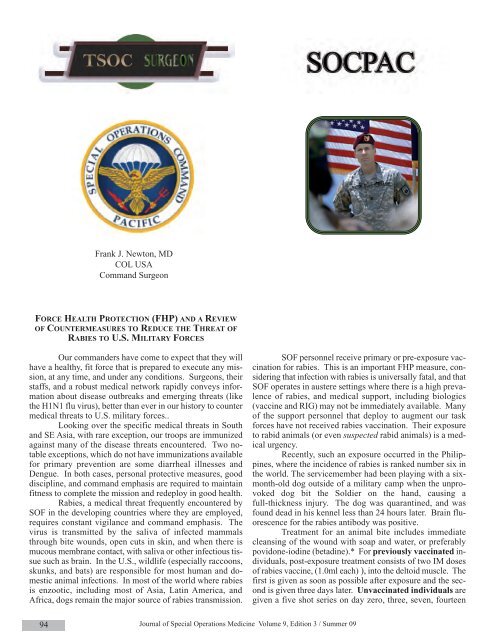Summer - United States Special Operations Command
Summer - United States Special Operations Command
Summer - United States Special Operations Command
You also want an ePaper? Increase the reach of your titles
YUMPU automatically turns print PDFs into web optimized ePapers that Google loves.
Frank J. Newton, MDCOL USA<strong>Command</strong> SurgeonFORCE HEALTH PROTECTION (FHP) AND A REVIEWOF COUNTERMEASURES TO REDUCE THE THREAT OFRABIES TO U.S. MILITARY FORCESOur commanders have come to expect that they willhave a healthy, fit force that is prepared to execute any mission,at any time, and under any conditions. Surgeons, theirstaffs, and a robust medical network rapidly conveys informationabout disease outbreaks and emerging threats (likethe H1N1 flu virus), better than ever in our history to countermedical threats to U.S. military forces..Looking over the specific medical threats in Southand SE Asia, with rare exception, our troops are immunizedagainst many of the disease threats encountered. Two notableexceptions, which do not have immunizations availablefor primary prevention are some diarrheal illnesses andDengue. In both cases, personal protective measures, gooddiscipline, and command emphasis are required to maintainfitness to complete the mission and redeploy in good health.Rabies, a medical threat frequently encountered bySOF in the developing countries where they are employed,requires constant vigilance and command emphasis. Thevirus is transmitted by the saliva of infected mammalsthrough bite wounds, open cuts in skin, and when there ismucous membrane contact, with saliva or other infectious tissuesuch as brain. In the U.S., wildlife (especially raccoons,skunks, and bats) are responsible for most human and domesticanimal infections. In most of the world where rabiesis enzootic, including most of Asia, Latin America, andAfrica, dogs remain the major source of rabies transmission.SOF personnel receive primary or pre-exposure vaccinationfor rabies. This is an important FHP measure, consideringthat infection with rabies is universally fatal, and thatSOF operates in austere settings where there is a high prevalenceof rabies, and medical support, including biologics(vaccine and RIG) may not be immediately available. Manyof the support personnel that deploy to augment our taskforces have not received rabies vaccination. Their exposureto rabid animals (or even suspected rabid animals) is a medicalurgency.Recently, such an exposure occurred in the Philippines,where the incidence of rabies is ranked number six inthe world. The servicemember had been playing with a sixmonth-olddog outside of a military camp when the unprovokeddog bit the Soldier on the hand, causing afull-thickness injury. The dog was quarantined, and wasfound dead in his kennel less than 24 hours later. Brain fluorescencefor the rabies antibody was positive.Treatment for an animal bite includes immediatecleansing of the wound with soap and water, or preferablypovidone-iodine (betadine).* For previously vaccinated individuals,post-exposure treatment consists of two IM dosesof rabies vaccine, (1.0ml each) ), into the deltoid muscle. Thefirst is given as soon as possible after exposure and the secondis given three days later. Unvaccinated individuals aregiven a five shot series on day zero, three, seven, fourteen94Journal of <strong>Special</strong> <strong>Operations</strong> Medicine Volume 9, Edition 3 / <strong>Summer</strong> 09
















